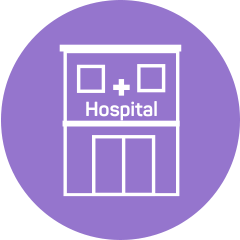

Abortion
methods
Abortion
methods
General information
An abortion is an intimate and personal procedure that can only be requested by the pregnant woman according to the local regulation conditions.
Dedicated structures, such as abortion centers (termination of pregnancy centers), family planning centers, physician’s offices and clinics/hospitals are available to help, inform, and assist you in making the decision that is appropriate for your situation. Medical practitioners are obliged to follow certain procedures to ensure personal, confidential treatment. If you wish you can talk to a qualified counsellor (marital and family counsellor, psychologist or social worker).
If you decide to terminate your pregnancy, an initial medical visit is required to determine your gestational age. Your physician will then give you all the information on the different methods (depending on your country regulations), on subjects such as:
Some countries require compliance with a reflection period between the pregnancy confirmation visit and the start of the abortion procedure. If this is the case, this period must be considered when making a decision about the abortion method.
Abortion is a medical act and so, it may entail some risks and complications. Consult your physician and make sure that you have acquired all the information you need. Only health care professionals are allowed to perform this act.
There are two different abortion methods: the medical method with medication and the surgical method performed by vacuum aspiration under anesthesia.
Fiala C et al. Early Medical Abortion, a practical guide to healthcare professionals. 2nd Edition, 2018.


Abortion
methods
General information
An abortion is an intimate and personal procedure that can only be requested by the pregnant woman according to the local regulation conditions.
Dedicated structures, such as abortion centers (termination of pregnancy centers), family planning centers, physician’s offices and clinics/hospitals are available to help, inform, and assist you in making the decision that is appropriate for your situation. Medical practitioners are obliged to follow certain procedures to ensure personal, confidential treatment. If you wish you can talk to a qualified counsellor (marital and family counsellor, psychologist or social worker).
If you decide to terminate your pregnancy, an initial medical visit is required to determine your gestational age. Your physician will then give you all the information on the different methods (depending on your country regulations), on subjects such as:
Some countries require compliance with a reflection period between the pregnancy confirmation visit and the start of the abortion procedure. If this is the case, this period must be considered when making a decision about the abortion method.
Abortion is a medical act and so, it may entail some risks and complications. Consult your physician and make sure that you have acquired all the information you need. Only health care professionals are allowed to perform this act.
There are two different abortion methods: the medical method with medication and the surgical method performed by vacuum aspiration under anesthesia.
Fiala C et al. Early Medical Abortion, a practical guide to healthcare professionals. 2nd Edition, 2018.


Medical abortion
Medical abortion is induced by 2 medications acting synergistically and taken 36-48h apart. It is performed in a maximum of three steps after confirmation and dating of the pregnancy.
Depending on your country’s regulations, you may be given the choice to terminate your pregnancy in a healthcare facility (hospital, authorized clinic), a doctor’s premise or at home for part of the process. In the last case, make sure that a family member and/or a friend is available to support you if needed. In addition, you should be aware of adverse events associated with medical abortion and whom to contact if complications occur.
Not all healthcare facilities perform medical abortion. We suggest that you get information from your local family planning center to find the closest physician or center.
Fiala C et al. Early Medical Abortion, a practical guide to healthcare professionals. 2nd Edition, 2018.

First medication intake
The first drug is taken orally in front of a healthcare professional (doctor or midwife). After the intake you can generally resume your normal activities.
You may experience side effects such as pain, nausea, vomiting, diarrhea, light cramping, or even bleeding.
If you want to know more about the side effects, contraindications or precautions for use, please refer to the medication’s leaflet.

Second medication intake (prostaglandin)
(36-48 hours after)
According to your local regulations you can take the second drug either at a medical facility or at home. In the latter case, make sure that a family member or a friend is available to support you if needed.
In the following hours, bleeding and pain are likely to occur. You can take the painkillers prescribed by you physician. If strong pain persists despite painkillers, contact your physician and go to the prescribing center. Your physician should inform you as to whom you should contact and where to go in the event of any problem emerging.
Expulsion usually happen within 4h after the administration of the second drug and can take up to 72 hours.

Control visit
(14-21 days after the first medication intake)
This follow-up visit is mandatory and allows to attest the success of the procedure by verifying that the pregnancy has been terminated. To do so, your physician will perform clinical and medical examination (ultrasound scan, β-hCG (beta human chorionic gonadotropin) urine/blood test)
In the event of failure, your physician will advise about your options. After an abortion, fertility resumes with the next menstrual cycle. That is why, if not discussed before, your physician will advise you on contraception to give you the most appropriate method.

First medication intake
The first drug is taken orally in front of a healthcare professional (doctor or midwife). After the intake you can generally resume your normal activities.
You may experience side effects such as pain, nausea, vomiting, diarrhea, light cramping, or even bleeding.
If you want to know more about the side effects, contraindications or precautions for use, please refer to the medication’s leaflet.

Second medication intake (prostaglandin)
(36-48 hours after)
According to your local regulations you can take the second drug either at a medical facility or at home. In the latter case, make sure that a family member or a friend is available to support you if needed.
In the following hours, bleeding and pain are likely to occur. You can take the painkillers prescribed by you physician. If strong pain persists despite painkillers, contact your physician and go to the prescribing center. Your physician should inform you as to whom you should contact and where to go in the event of any problem emerging.
Expulsion usually happen within 4h after the administration of the second drug and can take up to 72 hours.

Control visit
(14-21 days after the first medication intake)
This follow-up visit is mandatory and allows to attest the success of the procedure by verifying that the pregnancy has been terminated. To do so, your physician will perform clinical and medical examination (ultrasound scan, β-hCG (beta human chorionic gonadotropin) urine/blood test)
In the event of failure, your physician will advise about your options. After an abortion, fertility resumes with the next menstrual cycle. That is why, if not discussed before, your physician will advise you on contraception to give you the most appropriate method.
Abortion
methods
Any of the above visit may be performed remotely by telemedicine if your local regulations allow it.
At any time during the procedure you might also feel the need for a psychological support.
Please refer to your medication’s leaflet or your doctor to learn more about potential contraindications, other uncommon side effects associated to the medical method and precautions of use of the medications. Remember that bleeding and pain are, to some extent, part of the abortion process since, from a medical standpoint, medically induced abortion is similar to spontaneous abortion, or miscarriage.
Beware, although rare, complications may occur. That is why, as with all medical procedures, vigilance is advised. In the event of fever (lasting more than 24 hours), malaise, pain that persists despite analgesics, and/or heavy/persistent bleeding (the use of more than two sanitary pads per hour for more than two hours over the first two days and/or if bleeding lasts more than 12 days), you must immediately contact your physician or the facility in which the abortion was performed.
Abortion
methods
Any of the above visit may be performed remotely by telemedicine if your local regulations allow it.
At any time during the procedure you might also feel the need for a psychological support.
Please refer to your medication’s leaflet or your doctor to learn more about potential contraindications, other uncommon side effects associated to the medical method and precautions of use of the medications. Remember that bleeding and pain are, to some extent, part of the abortion process since, from a medical standpoint, medically induced abortion is similar to spontaneous abortion, or miscarriage.
Beware, although rare, complications may occur. That is why, as with all medical procedures, vigilance is advised. In the event of fever (lasting more than 24 hours), malaise, pain that persists despite analgesics, and/or heavy/persistent bleeding (the use of more than two sanitary pads per hour for more than two hours over the first two days and/or if bleeding lasts more than 12 days), you must immediately contact your physician or the facility in which the abortion was performed.


Surgical abortion
Surgical abortion is an instrumental procedure that involves vacuum aspiration, performed in the vast majority of cases under anesthesia. It is carried out by a physician in an operating theatre of a medical facility.
The procedure is performed in two steps, subject to variation according to your local regulations, after the confirmation and dating of pregnancy.

Surgical procedure
The surgical intervention which consists in a vacuum aspiration, is done under local or general anesthesia.
Based on your medical records, the anesthesiologist will rule out beforehand any potential contraindication to anesthetics. The physician could also give you a medicine to take 36 to 48 hours before the intervention to prepare the cervix for surgery. You may as well be prescribed an antibiotic prophylaxis to prevent infectious complications.
The abortion procedure lasts about twenty minutes. You will then be transferred to a post-anesthesia care unit for monitoring. A couple of hours is generally required to recover regardless the method of anesthesia chosen. Depending on your country’s regulations, for local anesthesia you will get home the same day, and for general anesthesia you may be asked not to go home alone and to be accompanied by a relative or a friend.
In the days that follow a surgical termination of pregnancy, you may experience post-operative bleeding and pain. These signs are the result of the surgical procedure and do not necessarily require you to see your physician. The bleeding and pain should gradually diminish.

Control visit
(14-21 days after)
This follow-up visit is mandatory and allows to attest that the pregnancy has been terminated by clinical examination by your physician and measure of β-hCG levels, either in the urine or blood.
After an abortion, fertility resumes with the next menstrual cycle. That is why, if not discussed before, your physician will advise you on contraception to give you the most appropriate method.

Surgical procedure
The surgical intervention which consists in a vacuum aspiration, is done under local or general anesthesia.
Based on your medical records, the anesthesiologist will rule out beforehand any potential contraindication to anesthetics. The physician could also give you a medicine to take 36 to 48 hours before the intervention to prepare the cervix for surgery. You may as well be prescribed an antibiotic prophylaxis to prevent infectious complications.
The abortion procedure lasts about twenty minutes. You will then be transferred to a post-anesthesia care unit for monitoring. A couple of hours is generally required to recover regardless the method of anesthesia chosen. Depending on your country’s regulations, for local anesthesia you will get home the same day, and for general anesthesia you may be asked not to go home alone and to be accompanied by a relative or a friend.
In the days that follow a surgical termination of pregnancy, you may experience post-operative bleeding and pain. These signs are the result of the surgical procedure and do not necessarily require you to see your physician. The bleeding and pain should gradually diminish.

Control visit
(14-21 days after)
This follow-up visit is mandatory and allows to attest that the pregnancy has been terminated by clinical examination by your physician and measure of β-hCG levels, either in the urine or blood.
After an abortion, fertility resumes with the next menstrual cycle. That is why, if not discussed before, your physician will advise you on contraception to give you the most appropriate method.
Keep in mind that surgical abortion is an invasive procedure and some side effects like pain and blood loss are part of the process. Though women may experience it differently.
Beware, although rare, complications may occur, such as hemorrhage, injury to the uterus, infection or a problem related to anesthesia. That is why, vigilance is advised, and you must contact your physician in case of fever, significant blood loss, strong abdominal pain, or malaise.
For more information on abortion, we invite you to consult your closest healthcare professional, who will also provide you with the contact details of a nearby abortion center.
Comparison of the two abortion methods

| Method | Medical abortion | Surgical abortion/aspiration |
|---|---|---|
| Performed by | The patient, who takes the tablet independently. More responsibility for the woman. | A trained professional (usually a doctor). The professional takes the responsibility. |
| When | 4 to 9 weeks* of amenorrhea | 6 to 14 weeks of amenorrhea |
| Duration | Several days | 3 to 10 minutes |
| Visits | 1 to 4 visits (counselling incl.) depending on the country or the professional. Possible to plan according to patient’s preference. | 1 to 3 visits (counselling incl.) depending on the country or the professional. Planned according to clinic schedule. |
| Additional medication | Painkillers in most cases. | Local or general anaesthesia. Painkillers. |
| Bleeding | More difficult to predict and control. Usually a bit stronger and longer than menstruation (i.e., 80 ml). | Same total blood loss as medical, but fewer days of bleeding after the procedure. |
| Side-effects** | Cramp-like pain (frequent), nausea and (rarely) vomiting or diarrhoea. | Sometimes short cramp-like pain, nausea and vomiting after surgery. |
| Complications (very rare) | Heavy bleeding, ongoing pregnancy, and infection. | Injury to the uterus, infection, problems of anaesthesia. |
| Effects on fertility | None | None if correctly performed and without complications. |
| Contraception | Effective method needed immediately. | Effective method needed immediately. |
* This limit may be extended according to the country regulations.
** Other side effects may occur. (Refer to the drug leaflet)
Fiala C et al. Early Medical Abortion, a practical guide to healthcare professionals. 2nd Edition, 2018, p.42.

